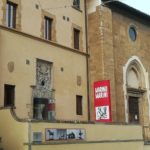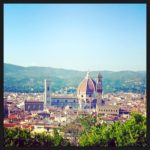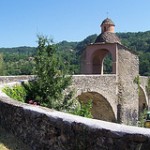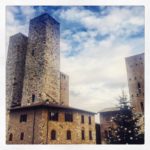City of Pisa
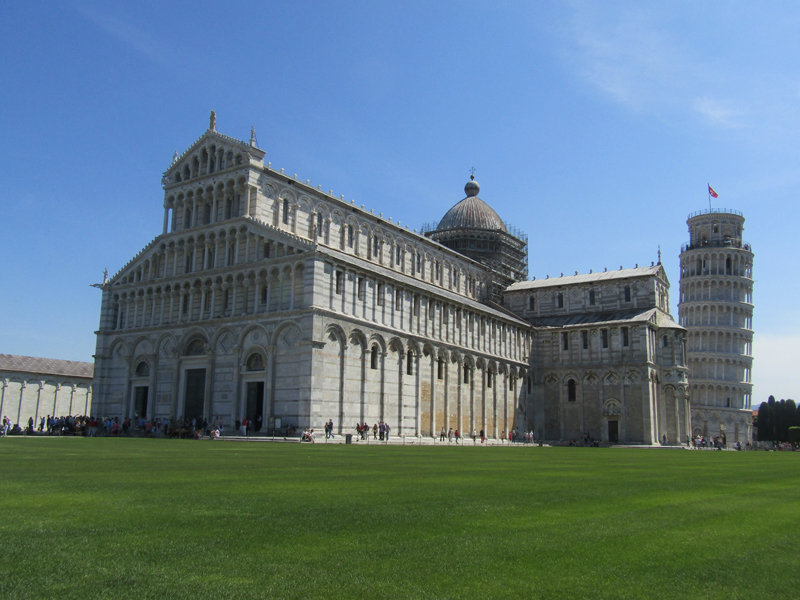
Piazza dei Miracoli (Unesco World Heritage Site)
A short walk alongside the medieval walls, among the sounds and colors of a multi-ethnic open-air market, to a welcoming arch, and behold a miracle! For a moment, we are transfixed by the breathtaking magnificence of the world-famous square. Four of the most incredible marble landmarks, ever conceived by man, appear before us in dazzling splendor. The Leaning Tower, Cathedral, Baptistery, and Monumental Cemetery have stood for over a thousand years, symbols of Christianity and the glory of the ancient Maritime Republic of Pisa.
Meet the guide and visit:
- The Cathedral, built in 1063 by Buschetto, one of the most important Italian architects. Inside its imposing structure, there are a series of paintings and marble and bronze sculptures. The 13th-century mosaic, attributed to Cimabue, distinctly stands out as does the monumental marble pulpit, from the same period, by Giovanni Pisano.
- The Baptistery, designed by the architect Diotisalvi in 1153, at the height of Pisa’s involvement in the crusades, and enlarged by eminent architects on several occasions in the following centuries.
- The Leaning Tower, one of the wonders of the world, has defied the laws of gravity for over a thousand years. Due to its inclination, it was chosen by the well-known physicist of Pisa, Galileo Galilei, as the ideal place to test these laws of gravity.
- The Monumental Cemetery, with its imposing frescoes and funeral monuments, depicts the “life” and events in Pisa from its Etruscan-Roman origins to the 20th century.
There is an entrance fee to all the above monuments.
City of Pisa
Visiting the most representative squares and monuments in the city, allows the visitor to learn more about the historical and artistic development of Pisa.
Meet the guide and visit:
- Piazza dei Miracoli (UNESCO World Heritage Site), with the Leaning Tower, Cathedral, Baptistery and Monumental Cemetery (entrance fees). This square is the highest expression of Pisa Romanesque style and a symbol of the maritime power Pisa held during the Middle Ages.
- Piazza dei Cavalieri: Walking along one of the oldest streets of the city, we reach the square that was the political and commercial heart of Pisa during the Middle Ages and subsequently, the symbol of the Medicean dominion. Flanking the square are the splendid palazzo of La Scuola Normale Superiore, the Tower of Count Ugolino, remembered by Dante, and the Church of Santo Stefano dei Cavalieri (entrance fee).
- Borgo Stretto: a very characteristic medieval street lined with elegant shops and enticing cafés. It is the heart of the city. Walking under its arcades, we reach the Church of San Michele, characteristic for its splendid façade.
- Lungarni: Walking along the banks of the Arno River, in addition to many noble palazzos and ancient tower-houses (case-torri), we can admire the small Gothic church, Santa Maria della Spina, the bridges, and the Cittadella with its Guelph tower and Medicean arsenal where the ships of the order of Cavalieri di Santo Stefano were armed.
Palazzos and Museums
It is possible to change or extend the city tour to include a visit to some of Pisa’s most prestigious museums.
Museo Nazionale di San Matteo
One of the most important Italian museums of medieval art, it is a testament to the political prestige, the economy and cultural wealth of the Maritime Republic of Pisa. This National Museum houses works by the most important artists, painters, sculptors, miniaturists, and goldsmiths who worked during the Middle Ages and Renaissance, like Donatello and Masaccio. It has an exceptional number of painted crosses, polyptychs, and gold-ground panel paintings (entrance fee).
Museo dell’Opera del Duomo
This museum is representative of the principal school of sculpture in Pisa. It houses a series of sculptures originally from the prestigious buildings in Piazza dei Miracoli. Of particular interest are works by Nicola and Giovanni Pisano. It also houses an Egyptian collection donated by Ippolito Rossellini, who took part in an Egyptian expedition with Jean François Champollion in 1828. There are also Etruscan and Roman finds, historical evidence of ancient settlements in the territory of Pisa (entrance fee).
Museo delle Sinopie
This museum was founded in 1985 and houses the “sinopie” salvaged from the Monumental Cemetery.
The “sinopie ” were preliminary drawings sketched by the artists before they frescoed a wall. They are representative of the important murals that decorated the monumental cemetery between the 14th and 17th centuries. Unfortunately many of these precious frescoes were irreparably damaged during World War II (entrance fee).
Museo di Palazzo Reale
Built by the Medici family in the 16th century, the palazzo later became the favorite residence of the Lorena (Lorraine) and Savoia (Savoy) families. Today it houses some of the finest art and furnishings from the most important private collections in Pisa, including paintings by Rosso Fiorentino, Raffaello and Guido Reni (entrance fee).
Palazzo Blu
Palazzo Blu, so called because of its blue façade, located on Lugarno Gambacorti, is one of the most significant examples of the architecture of the aristocracy of Pisa. Today it is used as an exhibition center for both permanent and temporary exhibitions and for several cultural activities.
The Palazzo’s intent is to further enrich the quality of cultural offerings in Pisa. The permanent exhibition covers the period in Pisa’s art history from the Middle Ages to present day, with works of great quality and importance by artists such as Orazio and Artemisia Gentileschi, Benozzo Gozzoli, Cigoli, various Macchiaioli painters, and sculptor Nino Pisano. The Palazzo still has many of its original furnishings. These, combined with the art displayed, convey the prestigious atmosphere of an ancient mansion.
The spaces for temporary exhibitions have hosted the works of some of the most celebrated artists including Dalì, Modigliani, Magritte, Picasso, Kandinsky, and Warhol (entrance fee).
Please note: Entrance fees are extra.
